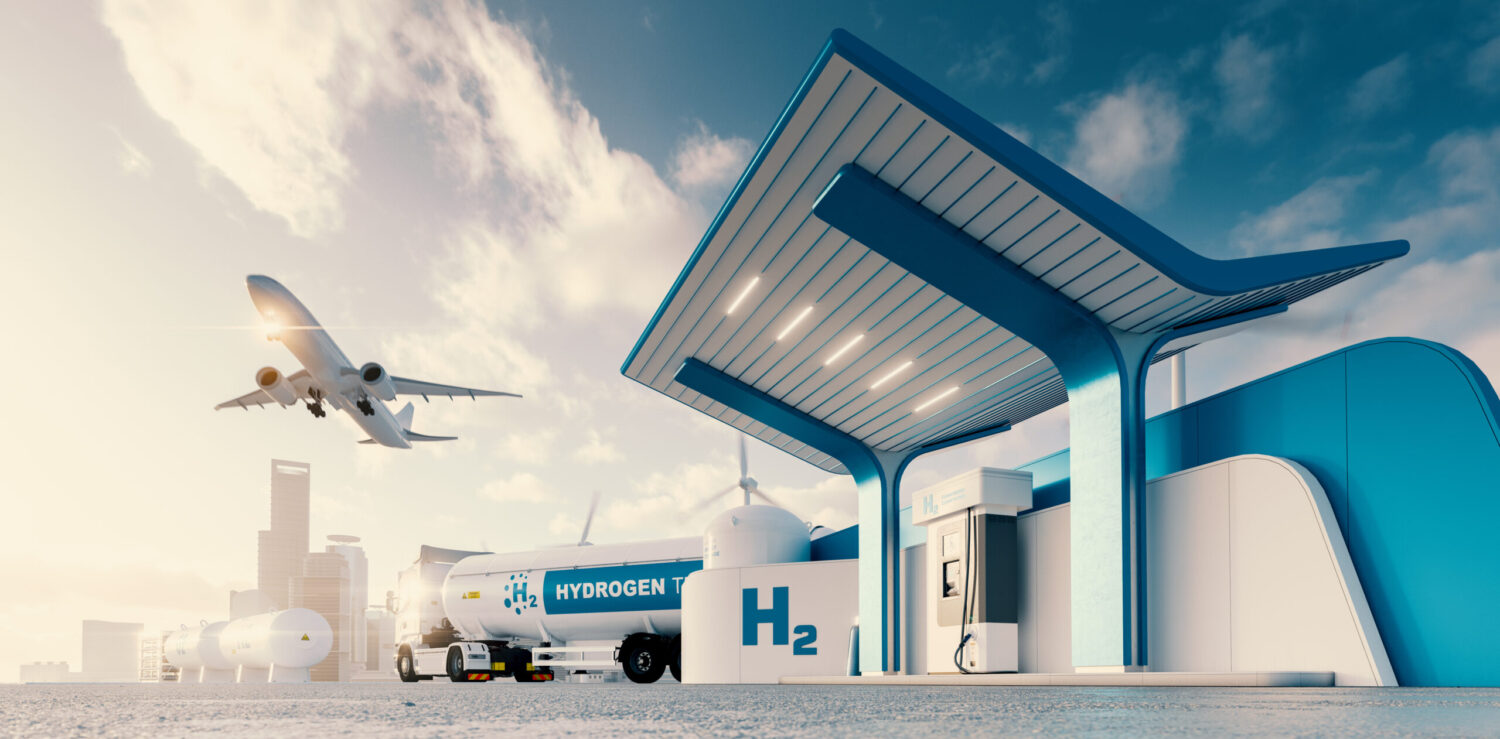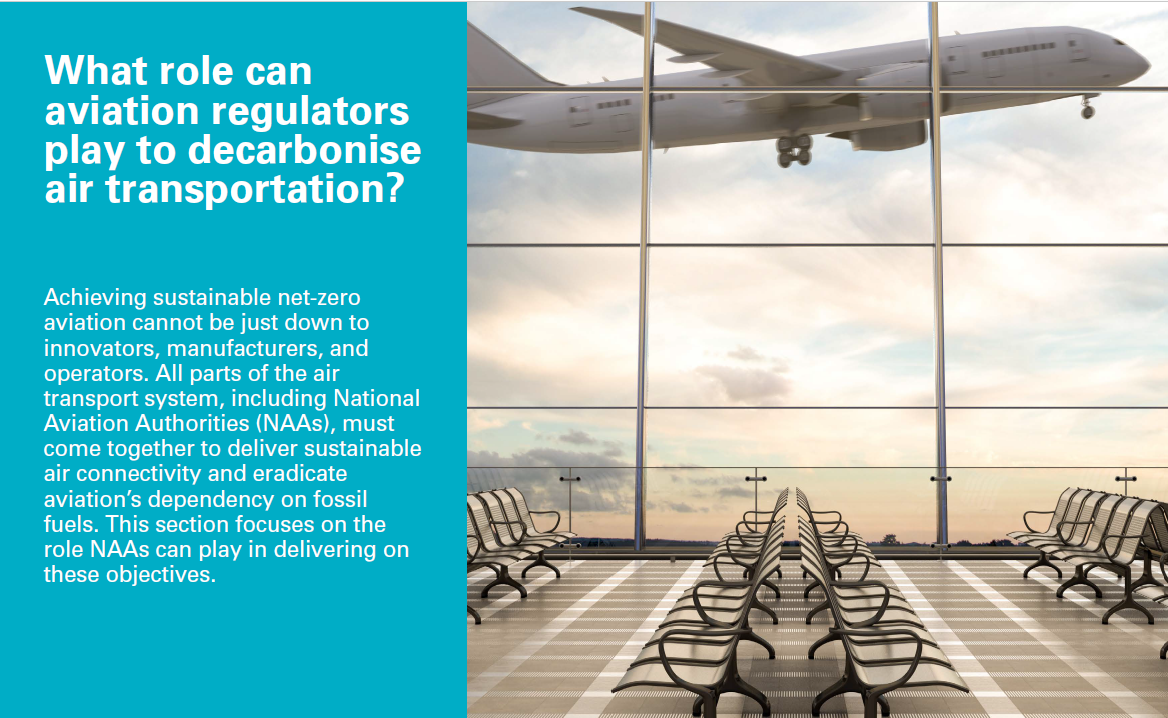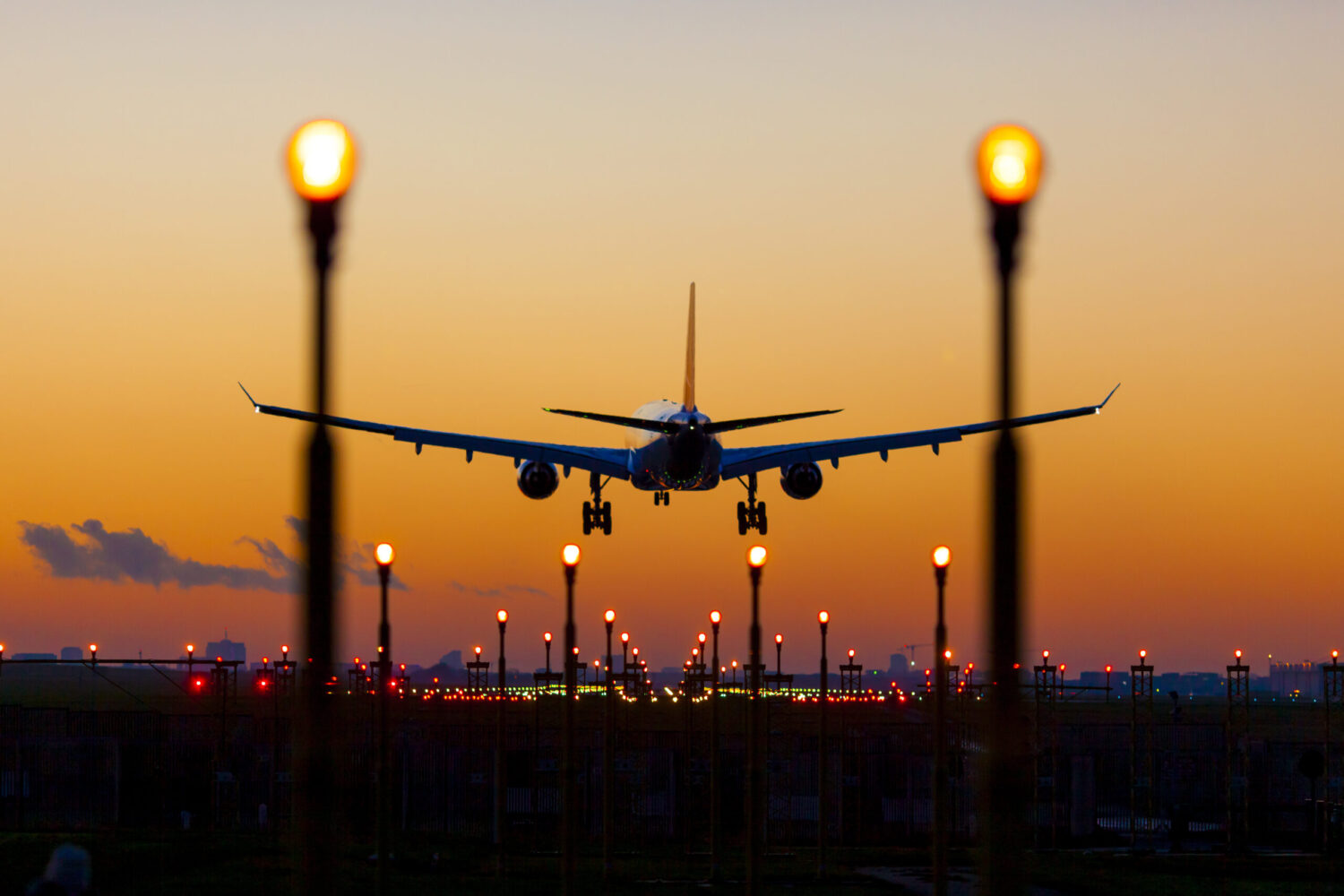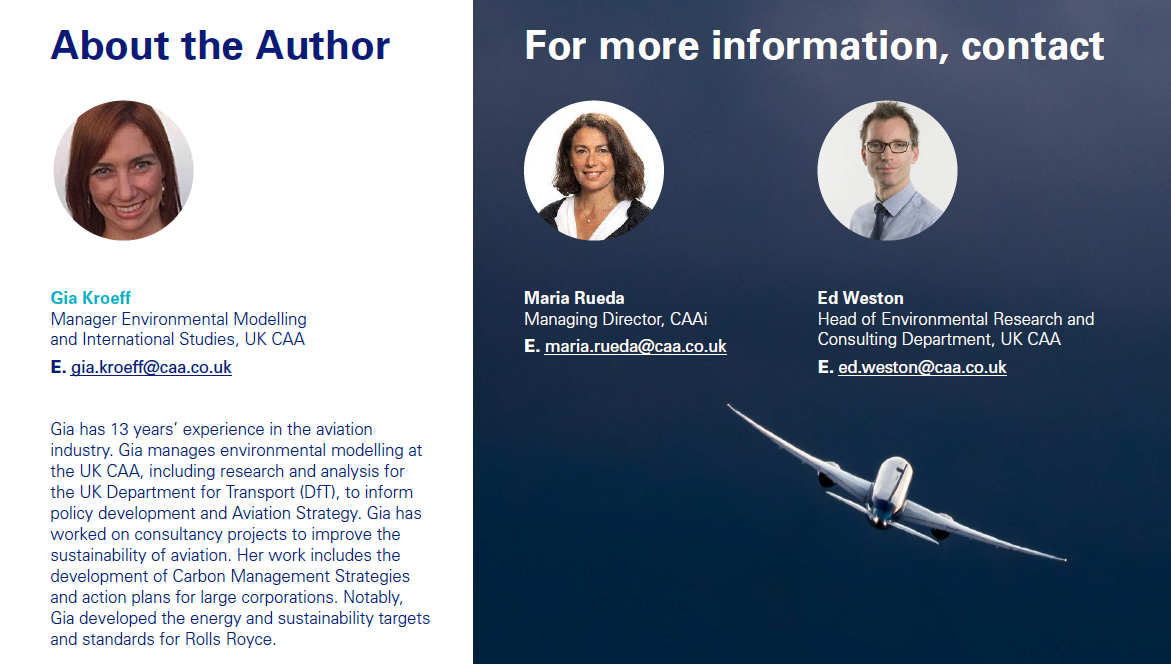Aviation and aerospace connect people, cultures, and businesses like no other form of transport. Aviation directly contributes to the UN Sustainable Development Goals (SDGs), and plays an integral role in improving and transforming people’s lives around the world. Global aviation produces around 2 per cent of all human-induced carbon dioxide emissions and 12 per cent of CO2 emissions from all transport sources. If aviation were a country, it would be the sixth-largest emitter, falling between Russia and Japan.
Climate change is now the most significant challenge of our generation. To protect the future of our planet, everyone in the aviation and aerospace sector – including regulators and national aviation authorities – must contribute to effectively reducing carbon emissions. Regulators have an essential role in ensuring that the sector is fully prepared and more climate-resilient. They must also ensure safety, security, and environmental standards are met, and consumers’ rights are protected.
Aviation’s main environmental impact stems from the noise, heat, ultra-fine particles, and the gases emitted by aircraft combustion engines, all directly contributing to our ecosystem and climate change. The Intergovernmental Panel on Climate Change (IPCC) considers that aviation emissions contribute to 4.9% of human-caused climate change.
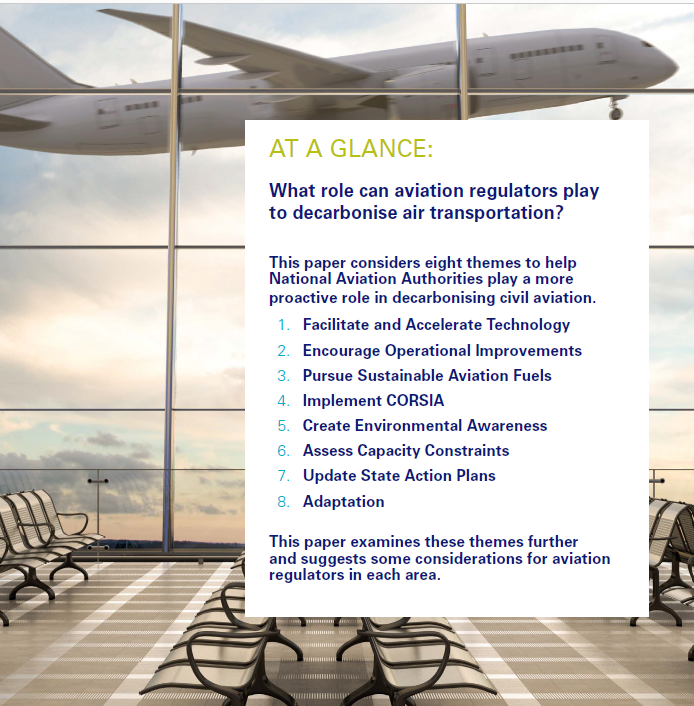 Key players across the global aviation and aerospace sectors are now working together to shape the future of flight. In the UK, the Aerospace Technology Institute, backed by the UK Government, has launched FlyZero Project. This one-of-a-kind research project brings together experts from across the UK to study the design challenges, manufacturing demands, operational requirements, and market opportunity for potential zero-carbon emission aircraft concepts. Aircraft and engine manufacturers are pioneering new technologies to realize net-zero carbon air travel. And airports are working to realize sustainable airport design and reduce their environmental impact, from air quality, noise pollution and waste generation to wildlife management and watercourses.
Key players across the global aviation and aerospace sectors are now working together to shape the future of flight. In the UK, the Aerospace Technology Institute, backed by the UK Government, has launched FlyZero Project. This one-of-a-kind research project brings together experts from across the UK to study the design challenges, manufacturing demands, operational requirements, and market opportunity for potential zero-carbon emission aircraft concepts. Aircraft and engine manufacturers are pioneering new technologies to realize net-zero carbon air travel. And airports are working to realize sustainable airport design and reduce their environmental impact, from air quality, noise pollution and waste generation to wildlife management and watercourses.
Meanwhile, there is limited research and guidance to suggest what else aviation regulators or national aviation authorities (NAAs) can do to play their part in decarbonising air transportation. After all, it is the role of the NAA to ensure that international standards are applied and that a solid regulatory framework and system exists to support and sustainably grow its air transport sector.
To formulate this vision and help the future of flight flourish, this paper summarises some of the outcomes from COP26, and what they may mean for the aviation industry. It also offers recommendations for aviation regulators to help decarbonise air transport and tackle climate change.
Recapping the 2021 COP26 Conference
The 2021 COP26 conference aimed to accelerate traction towards the goals of the Paris Agreement and the UN Framework Convention on Climate Change.
The United Nations 26th Conference of Parties (COP26) was held in Glasgow. It was an important year for the negotiations and the review of the Paris Agreement (legally binding international treaty on climate change) progress. It has been five years since the Nationally Determined Contributions (NDCs) were agreed – the climate action plans to cut emissions and adapt to climate impact. Since then, new information and data has been published by the IPCC.
The recent IPCC findings suggest that the increase in emissions could lead to global warming up to 2.7°C by the end of the century. As a result, the COP presidency urged all countries to increase their NDCs via national measures since there is a smaller window of opportunity to act.
Several actions were proposed to fulfill the main objectives of COP26 to secure global net-zero by mid-century and to keep 1.5°C temperature increase within reach. These actions included:
- The creation of a roadmap for climate adaptation.
- Agreement on climate finance and Article 6 of the Paris Agreement.
During COP26 “Transport Day”, progress was presented on keeping to 1.5°C degrees from shipping, road transport, and aviation. In addition, the aviation sector introduced a coalition of States supporting the setting of a long-term goal to limit the global average temperature increase to 1.5°C, with an aim to having it approved during the 41st ICAO Assembly in 2022.
If the implementation of these actions proves successful, the commitments made at COP will limit the global temperatures to a 2.4°C increase, leaving a large gap to achieve a 1.5°C rise in temperature.
In recognition that the environment and global warming are of utmost importance, this paper presents how National Aviation Authorities can help reduce aviation impacts on the environment and accelerate the agreement and implementation of long-term greenhouse gas emission targets in line with a 1.5°C increase in temperature.
1) Secure global net-zero by mid-century and keep 1.5°C within reach
Several States took the opportunity to announce their net-zero targets by 2050, including the United Kingdom and Italy as co-hosts of COP26. With these commitments, 90% of G20 countries’ emissions are now covered under a net-zero target. To deliver these targets, several countries signed pledges that by 2030 they would reverse deforestation, end direct support to the international unabated fossil fuel in the energy sector, cut methane by 30% and phase down coal consumption. These initiatives will target to reduce an increase in temperatures from 2.7°C to 2.2°C. However, the agreements must be translated into actions by integrating them into the countries NDCs with clear policies implemented by governments and regulators. There is still a gap that will need to be addressed during COP27 in 2022.
2) Creation of a roadmap for climate adaptation
During COP26, the 6th IPCC WG1 Report was presented, highlighting that every additional increment of global warming worsens climate and weather extremes and their impacts on modern societies. COP26 aimed to work together to enable and encourage countries affected by climate change to take action to become more climate-resilient. But adaptation needs will continue to increase with the severity of impacts increasing with rising temperature.
This underlines the need to develop and integrate national adaptation plans into local, national, and regional planning, which will need drive and clarity from regulators amongst others, e.g. governments. The Adaptation Research Alliance was launched to catalyse investment in action-oriented research and innovation for adaptation.
3) Agree on climate finance
To achieve the goals in items 1 and 2, there was a need to agree on climate finance mobilizing by at least $100 billion per year. During COP26, more finance was mobilized than requested. There is now a need to take the pledges into action to mobilize the finances in 2022.
The importance of transparency was evident in the Climate Finance Delivery Plan’s collective efforts. It highlighted the importance of continually supporting developing countries and developing new technologies implemented as mitigation and adaptation actions.
This presents an opportunity for regulators to add transparency to the agreements without causing delays to the process. Several agreements were signed during COP26 to mobilize climate action among cities, businesses, and investors, accelerate the decarbonisation of the economy, and secure key elements of the Paris Agreement to vulnerable countries including loss and damage harms caused by man-made climate change.
4) Agreement on Article 6 of the Paris Agreement (cooperation to achieve NDCs)
The negotiations focused on finalizing the Paris Rulebook (Treaty that details how the Paris Agreement pledges can be met) and turning ambition into action. As part of the Paris Rulebook, a solution was agreed for carbon markets, covering transparency and broker agreement issues. It was agreed that the Internationally Transferred Mitigation Outcomes (emission reductions that pass from one country’s greenhouse gas inventory to another country’s inventory) would be used under the Carbon Offsetting and Reduction Scheme for International Aviation (CORSIA) or other international actions to reduce emissions.
![]() COP26: Transport
COP26: Transport
Driving the global transition to zero-emission transport
COP26 focused on how governments, industries and individuals can reduce carbon emissions caused by different transport modes. The outcomes included:
- A Declaration to support the establishment of green shipping corridors.
- A Declaration on accelerating the transition to 100% zero-emission cars and vans by 2040. Several countries, car manufacturers, and owners of large fleets committed to electrification by 2035, and the UK has committed to ending the sale of internal combustion engine vehicles by 2030.
- Establishment of an International Aviation Climate Ambition Coalition, covered in the next session, to advance ambitious actions to reduce aviation CO2 emissions at a rate consistent with efforts to limit the global average temperature increase to 1.5°C.
Overall, the initiatives presented didn’t reach a full pathway to how the transport sector will play its part to keep the global temperature rise below 1.5°C. This warrants more work for States and regulators to establish more stringent goals and actions for the transport sector.
COP26: Aviation
The main objective for aviation at COP26 was to support adopting an ambitious long-term goal consistent with the 1.5°C temperature limit by ICAO, given the industry’s commitments towards netzero CO2 emissions by 2050. The main achievements in aviation included:
- International Aviation Climate Ambition Coalition: A dedicated coalition was announced to support ICAO in adopting an ambitious long-term goal for emissions reduction in aviation at the 41st ICAO Assembly in 2022. The coalition encourages States to work together and encourage ambitious action on aviation emissions by governments worldwide. This initiative has opened the doors for National Aviation Authorities to engage with their national Governments and industry in establishing the steps that will lead them to commit and achieve net-zero emissions.
- Clean Skies for Tomorrow – Sustainable Aviation Fuel (SAF) Ambassadors: A SAF ‘policy toolkit was developed and launched at COP. The toolkit contains blueprints of innovative and practical SAF policy proposals that can be implemented by States, regulators and the industry in all regions and will be key for capacity building in certain countries. Carrying out a readiness level assessment by NAAs would be a simple first step for countries to create their path to SAF adoption.
- Delivering Jet Zero (UKs strategy for net-zero aviation) discussion: Key players from Government and industry discussed the importance of collaborative partnerships, like the UK’s Jet Zero Council. Such partnerships can help agree and pioneer how aviation can reach Jet Zero by 2050, including the current solutions available, and the innovations that need to be developed to meet the challenge. It was clear that strong collaboration between States and industry needs to happen and that regulators have a crucial role to play in collaboration and transparency.
With the 41st ICAO Assembly taking place in 2022, work is underway to encourage governments worldwide to adopt a long-term, global and aspirational goal for international aviation. This offers an excellent opportunity for States to join the International Aviation Climate Ambition Coalition and set their national targets. NAAs have a pivotal role to play in supporting States to be ready to accept the goals.
There is no single solution to achieve net-zero in aviation. Actions will include new energy efficiency measures, greater uptake of sustainable aviation fuels, new energy sources, new aircraft types/configurations and more significant implementation of CORSIA. Given the nature of air travel, these solutions need to be implemented at national and international levels.
At a national level, actions need to show leadership and establish the infrastructure to drive emission reductions forward. There are several ways that regulators can help reduce aviation emissions including, technology improvements, new technology, operational efficiencies, and the use of SAFs and CORSIA. At a global level, uptake from States to ICAO’s Long-Term Targets for Aviation Goal is essential. The agreements need to work at multiple city-pairs and international locations, and the same infrastructure needs to be in place at both ends of a flight. Collaboration between aviation regulators internationally is essential, and with energy and infrastructure national regulators to ensure supply of different energy types is also a bonus.
![]() Technology
Technology
Energy efficiency improvements are considered important in driving emissions down in the short term, but new technology will be vital in achieving net-zero emissions. For new technologies to be operational by 2050, the product design needs to be ready by 2030, so plenty of work will need to be undertaken in this decade.
Electrification is already being developed for regional flights and will likely play a role for short-haul and urban mobility in the future. NAAs serve a crucial role in safely facilitating and accelerating the certification process and coordinating the systems integration between the infrastructure, energy sources, and aircraft.
Hydrogen appears as the most likely fuel source candidate in the long term. There are currently three main approaches to using hydrogen (synthetic fuels, hydrogen combustion and hydrogen fuel cells). NAAs need to:
- Understand the latest research.
- Engage their industry and Government to anticipate and evaluate evolving hydrogen aircraft concepts.
- Anticipate the regulation changes and create the system approach required for designing and implementing new fuel sources, different infrastructure, and aircraft technologies changes that are compatible with each other.
Consideration also needs to be taken on the non-CO2 emissions trade-offs. Partnerships between industry and government like the UK’s Jet Zero CouncilXII, and programmes like Fly Zero are looking to accelerate the process and agree on a suitable solution by 2030. These close collaborations bring huge advantages in evaluating the potential changes to aviation regulation, coordinating and addressing with other sectors the opportunities to set up new infrastructure for different fuels and address challenges as they come along and facilitate public-private partnerships.
Operational improvements
During the COP26 Transport Day, the “Delivering Jet Zero” discussion concluded that an emission reduction of up to 8% can be achieved by improving the efficiency of aviation operations. During every phase of aircraft operation, there are opportunities to reduce fuel burn and, consequently, emissions.
There are several policy proposals that regulators can introduce, including making military air space flexible use and developing new systems for regulators to progress on national, regional, and global harmonization of standards. Regulators need to make sure they are making decisions in relation to the design and operation of airspace swiftly, while maintaining high standards of safety.
As an example, in 2018, EUROCONTROL (pan-European, civil-military organization dedicated to supporting European aviation) and the European Civil Aviation Conference (an intergovernmental organization that seeks to harmonize civil aviation policies and practices amongst its Member States) conducted an analysisXIV on Continuous Climb Operations (CCO) and Continuous Descent Operations (CDO) using 2017 traffic data to estimate the potential benefits of optimizing CCO and CDO. The results indicate that in Europe, the possible savings are up to 340,000 tonnes of fuel/year.
![]() Sustainable Aviation Fuels
Sustainable Aviation Fuels
Until new fuel sources and technologies are introduced, SAF will be crucial for achieving the carbon-neutral growth goal from 2020 for international aviation. Several States committed to 10% SAF usage by 2030, with leading countries such as Norway agreeing to 14%.
The main challenges for SAF are ensuring robust sustainability certification of the fuel (to ensure that fuel generates lower carbon emissions on a life cycle basis and is not made from biomass obtained from land with high carbon stock), the speed of building factory installations, the inability to ramp up production quickly, and the need for public-private partnerships to accelerate deployment. The SAF Policy Development toolkit introduced at COP26 was positively received, as it will facilitate SAF implementation in a broader range of States. With a relatively quick assessment to check readiness using the toolkit, NAAs can start implementing more concrete actions very quickly.
With six fuel production pathways currently certified by ICAO, eight airports (Bergen, Halmstad, Kalmar, Oslo and Los Angeles, Oslo, San Francisco, Stockholm and Vaxio) are already using biofuel. Six airlines (BRA, United Airlines, KLM, SAS, Finnair and Lufthansa) are using SAF on an ongoing basis. To build on this momentum, more States should assess the opportunity to implement SAFs and commit to a minimum 10% mandate by 2030 and if long-term SAF mandates as suitable. The establishment of airline routes that run 100% on SAF would present a new level of commitment that NAAs could work towards at a national level. Notably, NAAs will need to consider aircraft and engine certification, fuel production and fuel promotion when certifying SAF powered aircraft.
CORSIA
The introduction of CORSIA as a market-based measure to address CO2 emissions from international aviation is now in a voluntary phase. NAAs should encourage their Government to join this phase as soon as possible to limit emissions from international aviation to 2019 levels.
CORSIA currently only includes CO2 emissions. Consequently, the COP26 Jet Zero panel discussion highlighted a need to consider the non-CO2 impacts of aviation on climate change. In addition, regulators need to consider new metrics to compare the whole lifecycle impacts from different types of journeys, different aircraft, distances, fuel types, etc.
Other aspects worth considering include the expansion of CORSIA to include emissions reductions below 2019 levels. In addition, with the regulator’s support, Governments will need to decide if they will implement market-based measures in line with CORSIA for their domestic emissions or adopt a different scheme (perhaps tax-based) internally depending on how CORSIA progresses.
![]() Creating Environmental Awareness
Creating Environmental Awareness
Creating environmental awareness forms an essential part of the solution as it educates consumers and empowers them to make informed decisions about how they travel. Some behaviour change examples used in the aviation context include national policies that promote the least polluting option, business travel shifting to online meetings, airports increasing capacity for greener aircraft, airlines encouraging passengers to fly responsibly and providing environmental information to consumers.
There was no clear evidence that consumers were interested in environmental information to issue guidance on comparable standards just five years ago. However, in recent years, we have witnessed a shift in consumer attitudes driving the re-evaluation of environmental information.
At COP26, the Cambridge Accelerator Tool was unveiled to compare the impact of different technologies. This tool will allow stakeholders to obtain greater visibility of options for aviation emission reductions. However, little was discussed concerning consumers and the information air passengers need to make an informed air travel decision.
Deliberative research on the provision of environmental information to consumers commissioned by the UK CAA showed some key considerations for regulators during the design of environmental information. This included keeping information consistent, avoiding the use of industry jargon, reducing the effort of trade-offs, and communicating information front and centre at relevant points of the passenger journey. The research also showed that a ‘stamp of approval’ from the aviation regulator is significant for consumers. Regulators may also benefit from implementing new metrics that compare the whole lifecycle impacts for their domestic routes.
Capacity
The introduction of all the actions mentioned above is expected to keep aviation capacity unconstrained. To achieve net-zero aviation by 2050, the UK is focused on high technology uptake. Other countries, such as France, have implemented a ban on short-haul internal flights where the same journey could be made by train in under two-and-a-half hours to reduce CO2 emissions.
In this case, it will be a matter for Governments and aviation stakeholders to agree on the balance between investing in technology acceleration, emission reductions, and prioritizing routes best suited for aviation and introducing capacity constraints or demand management techniques to achieve the desired emission outcomes for their States.
![]() State Action Plans
State Action Plans
ICAO State Action Plans need to be updated at least every three years. However, the States that signed up to new pledges have submitted new action plans with clear actions explaining where the emissions reductions will come from.
To renew the action in line with long-term targets, NAAs will have to identify areas of modification in their existing organizational structure, collaborate with stakeholders, establish energy policies and programmes that provide opportunities to expand clean electricity sources to power aviation activities. Regulators will also have to optimize their organizational structure for effective monitoring, reporting, and verifying CO2 from international civil aviation.
Adaptation
Lastly, from an adaptation perspective, climate risk awareness is an important area for consideration. NAAs need to identify potential implications of climate change to all the different parts of the aviation system, such as, what airline routes are likely to be affected, assess existing vulnerabilities, and integrate actions to increase climate resilience into the national adaptation plans. This will allow planning and the creation of national roadmaps for climate adaptation. NAAs also need to report on how climate change will affect their ability to fulfill their functions in the future.
![]() Conclusion
Conclusion
Over the first two weeks of November 2021, Glasgow captured the world’s attention as the host city of COP26, and the centre of the debate around how to tackle our climate emergency. We can now say that the negotiations have kept the 2050 target of not exceeding 1.5°C alive, but we will only achieve it if commitments are translated into rapid action. A lot is still to be completed at COP27 in 2022.
For aviation, decarbonisation is a challenge that needs to be met by the whole system. There is no single answer – action is necessary across multiple domains. There is a need to speed up mitigation at a global and local scale in the short term, with particular emphasis on SAF implementation. In the long term, the focus will be on decarbonisation through new technologies and renewable energy.
NAAs have an essential role in ensuring that the sector is fully prepared and more climate-resilient, ensuring that safety, security and environmental standards are met, and consumers’ rights are protected. NAAs also have an instrumental role in creating awareness to all stakeholders, disseminating best practices and guidance.
Considering that aviation is a system, the ability to engage all stakeholders effectively, from the airports, airlines, air navigation service providers to the energy suppliers and local authorities, is a precondition to avoid the creation of islands of resilience, with no connection to the rest of the network.


